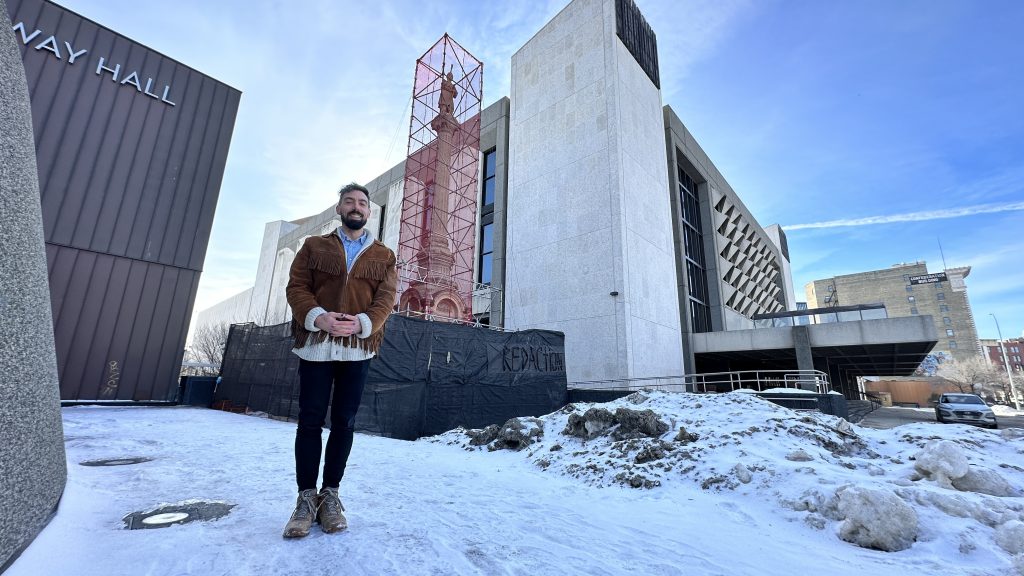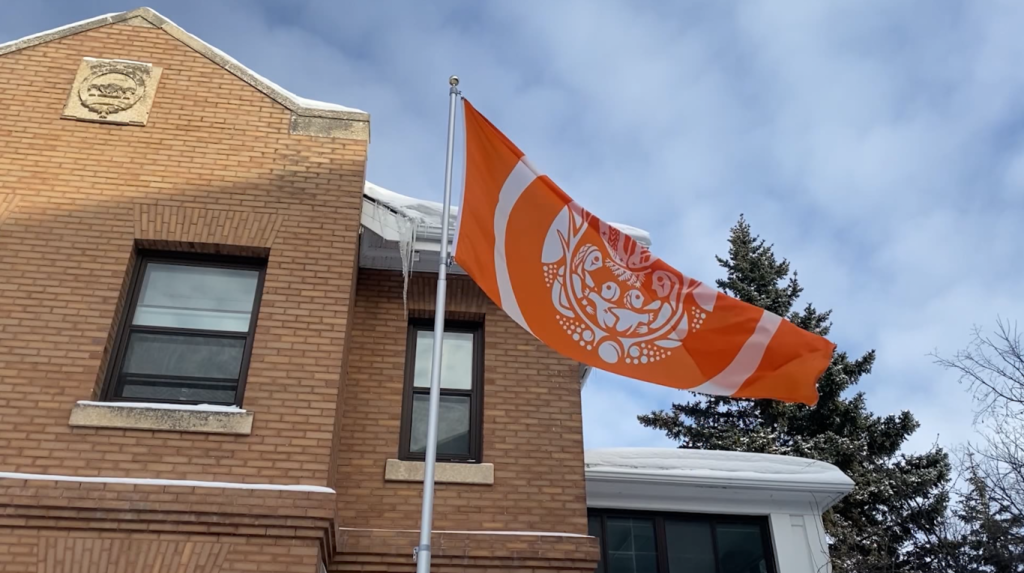‘Counter-narrative’: Métis artist challenges historical account by altering Winnipeg’s Volunteer Monument

Posted February 17, 2024 3:07 pm.
Last Updated February 18, 2024 12:13 pm.
A Métis artist in Winnipeg is challenging Manitoba’s past by temporarily altering a 140-year-old monument.
It’s a reflection of ongoing conversations about adding Indigenous perspectives to the collective history.
“I work and play in the Exchange District and I walk by a war monument dedicated to the people who volunteered to shoot down my ancestors, so I thought it was a unique opportunity to offer a counter-narrative for at least a brief period of time,” said artist Éric Plamondon.
“Redaction” is Plamondon’s first large-scale public art piece, which he calls “éphémère” – French for temporary. It’s a collaboration between Plamondon and Joe Kalturnyk, who helped with the technical elements of the scaffolding.

“Redaction” is placed around The Volunteer Monument, which commemorates the men of the 90th Winnipeg Battalion killed in the 1885 battles of Fish Creek and Batoche, along with the North West Rebellion.
“There’s been a lot of questions asked on, what do we do with monuments of this sort,” Plamondon reflected. “We’ve seen in recent years a bit throughout North America that there’s been debate on pieces that are placed in spaces of value and speak of a history that is isn’t full and maybe, I would suggest, not accurate.
“In Winnipeg for example, we saw the toppling of Queen Victoria at the (legislative building) and the beheading of Queen Elizabeth. But there’s tons of these monuments and one is the war monument that’s behind me, that’s dedicated to the ‘Little Black Devils,’ that was erected to honour the people who fell at Batoche in la Bataille de la Grenouillère, or Fish Creek.
“But only the names of the people who were part of the battalion, nothing about the Métis people that also fell during that period of time.”
WATCH: Métis artist Éric Plamondon speaks in French about his new art installation, Redaction.

Plamondon says the reaction to his piece has been largely positive, however he’s heard the 90th Battalion, The Royal Winnipeg Rifles, have been challenged by the new installation and Plamondon’s intent.
CityNews reached out to the Rifles, also nicknamed the “Little Black Devils,” but did not immediately receive a response.
“I’d like that the piece still allows the statue to be seen,” Plamondon said. “It’s bathed in red light and red netting, but it’s still there. So it poses the question – and I hope that they do become part of the conversation – but for 140 years, the statue has been in a place of importance in Winnipeg. I’m OK that for the next four weeks there’s a bit of a counter-narrative that’s presented.”
Plamondon says there can be many different interpretations of his piece, but his goal is to spark conversation about challenging existing historical narratives.
“I think society is in the place that is grappling with those questions of, how do we have a fuller understanding of history? How do we de-colonize our lens in the historic district of Winnipeg, an important district of Winnipeg?
“When people sort of look at Redaction or REDACtion, there is room for interpretation for, what do we do? Do we reconstruct? Do we deconstruct? Do we permit Red Actions or do we permit redaction of history? So it’s throwing ourselves into the debate in a way that I hope is approachable and accessible to all.”

Plamondon says he’s always been motivated by the relationship between art, space and audience.
“Art isn’t always behind gallery walls,” Plamondon said. “It should exist in the public space because it makes it more accessible and it means that it’s in conversation with community. I know it’s a big conversation right now, about why do we invest in public art. I feel like this is a good example of why we do it. It is about taking action towards Truth and Reconciliation. It is about allowing something new to emerge in the public space.
“If I can contribute a small amount to that, even temporarily, then it’ll be a success.”
Redaction can be found between the Manitoba Museum and the Centennial Concert Hall in Winnipeg until March 9 as part of The Lights On The Exchange – Allumez Le Quartier winter festival.








